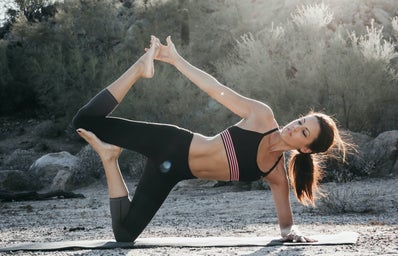There I was on a quiet fall Saturday afternoon at my local corner Starbucks, pondering life and all that was my Chestnut Praline Latte, when I looked up across the street and saw a sign that read, “One Week Free Yoga.” Free? It was in that moment that I realized that I knew there was something I could do beyond my athletic ability and at least try it out. That big orange sign at Corepower Yoga was probably one of the most influential signs I have ever read.
I have to be honest, I have no idea how I have done yoga for four years now and I still continue to love every practice. I remember going to that first class, clueless, and surrounded by a ton of pro-yogi moms and old men. I was 15 when I walked into my first class and technically wasn’t allowed to take them because they were “too hot” for a 15 year old, but not for a 16 year old. The manager said I was gonna be fine, and I was–for the most part.
Day One: The Beginning
Congratulations! You actually made it to your first, and hopefully not last, yoga class of your life. You do not need any type of expensive yoga gear–all you need is a mat, water, a towel, and the motivation and self discipline to get through the class, but also enjoy it for all the benefits it will give you. Make sure to show up at least 10 to 15 minutes early in order to secure a good spot in the studio, as you won’t want to be stuck facing a post and not knowing what pose to be in because your view is obstructed.
I don’t know why, but the first yoga class I went to was more advanced than your basic downward and upward facing dog. I decided to go to a sculpt class with weights–yes, heavy things you have to lift with every pose. It actually ended up being my favorite class, so take a class that will challenge you because you never know if it might become your new favorite workout.
Day Two: The “Regulars”
By the second day, you’re probably sore and don’t exactly know why you signed up for seven days of twisting and bending different ways, but still want to stick with it because there are more classes to try out. You’ll start to notice “regulars”, or yogis that stick with a specific time and class they go to after work or school. These people will be your friends when it comes to not knowing which pose to be in or what equipment to use at the start of class. You’ll notice that the instructor begins class by setting an intention of some sort. This is important because it helps you focus on the reason you showed up and sets the mood for your entire workout. Let it all slip off onto your mat.
Day Three: Inhale and Exhale
You’ll begin to notice that using your “yogi breath”, or pranayama, is one of the most important parts of class. While it may sound a bit funny, inhaling and exhaling aloud actually regulates your inside temperature throughout class. Also, breathing really helps you focus and stay in more uncomfortable or challenging postures longer so you really reap the benefits of each move.
Day Four: The Sweat
While there are many studios out there that continue not to use heat as a way to enhance your yoga practice, many say that using heat is the best way for our bodies to stretch and release toxins from our bodies. It may be a bit uncomfortable the first few days of sweating pints of water at your feet, but you’ll soon find that it’s actually one of the most refreshing and rejuvenating feelings. You’ll finish an hour of hot yoga and walk out of the warm studio, hair almost everywhere on your face, clothes sticking to your chest, and a smile on your face because you did it.
Day Five: The Community
By now you’ve probably seen many groups of people going to yoga together, people greeting the instructors like friends, and other yogis helping other yogis with postures. Yoga doesn’t have to be something you do alone. Yoga is great for being a practice of solitude, however, it can also help you connect with others. Going to yoga with friends, motivating each other to achieve your fitness goals, or just embracing everyone in the room for their personal goals is why yoga can be so universal and enlightening.
Day Six: Improvement
By the sixth day, there may be signs of little improvement being made as you continue your practices. It could be as little as being able to stretch to your toes or to being able to balance on one foot for a couple minutes. Everyone has their own ways of improving themselves and it takes time. There are little things we can do to improve ourselves: mentally and physically. Yoga helps us find ways for us to better ourselves.
It has taken me about two years to properly execute a headstand without falling on my face. I’ve learned that you can’t just quit when it comes to challenges you face on your mat and even everyday life. You’re going to fall on your face and it’s just a means of getting back up and trying again.
Day Seven: Savasana
Your last class might be the class you decide you either hate yoga or love it. You might even think you’re stronger or feel weaker because of it and that’s totally normal. I felt like spaghetti after my first week. That last savasana, or “corpse pose”, is where you soak up everything you’ve learned in class and you lay there wondering about all that the class has made you do or even think about. Hopefully you reflect on the challenges you’ve faced and the obstacles you’ve won.
I know that yoga isn’t for everyone, and being in a room with a lot of sweaty and empowering people may not being everyone’s cup of tea, but it’s mine and I hope that it inspires someone to go out and take advantage of a free week of yoga.


